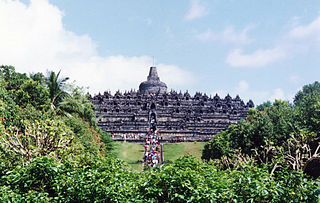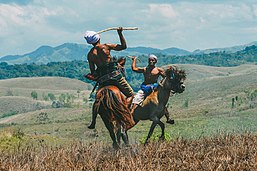
Kuntao or kuntau is a Hokkien term for the martial arts of the Chinese community of Southeast Asia, specifically the Malay Archipelago. It is most commonly practiced in and associated with Indonesia, Malaysia, the Philippines and Singapore.

The Sui people, also spelled as Shui people, are an ethnic group living mostly in Guizhou Province, China. They are counted as one of the 56 ethnic groups officially recognized by the People's Republic of China.

The karambit or kerambit, kurambik or karambiak is a small curved knife resembling a claw. It is most closely associated with the Minangkabau people of West Sumatra, Indonesia, but is also found throughout other ethnic groups in Southeast Asia. The karambit is one of the weapons commonly used in pencak silat and Filipino martial arts.

Chuseok, also known as Hangawi, is a major mid-autumn harvest festival and a three-day holiday in South Korea celebrated on the 15th day of the 8th month of the lunisolar calendar on the full moon. In North Korea, they only celebrate for the day of chuseok. Like many other harvest festivals around the world, it is held around the autumn equinox, i.e. at the very end of summer or in early autumn. It is the biggest traditional holiday in South Korea.

Samurai 7 is a 2004 anime television series produced by Gonzo and based on the 1954 Akira Kurosawa film Seven Samurai. The seven samurai have the same names and similar characteristics to their counterparts from the original. The series was directed by Toshifumi Takizawa, and its music was composed by Kaoru Wada and Eitetsu Hayashi. There are 26 episodes.

Qiang is the Chinese term for spear. Due to its relative ease of manufacture, the spear in many variations was ubiquitous on the pre-modern Chinese battlefield. It is known as one of the four major weapons, along with the gun (staff), dao (sabre), and the jian, called in this group "The King of Weapons".

Pencak silat is an umbrella term for a class of related Indonesian martial arts. In neighbouring countries, the term usually refers to professional competitive silat. It is a full-body fighting form incorporating strikes, grappling, and throwing, in addition to weaponry. Every part of the body is used and subject to attack. Pencak silat was practiced not only for physical defense but also for psychological ends. There are hundreds of different pencak silat styles and schools which tend to focus either on strikes, joint manipulation, weaponry, or some combination thereof.
Indian martial arts refers to the fighting systems of the Indian subcontinent. A variety of terms are used for the English phrases "Indian martial arts", deriving from ancient sources. While they may seem to imply specific disciplines, by Classical times they were used generically for all fighting systems.

A blood sport or bloodsport is a category of sport or entertainment that involves bloodshed. Common examples of the former include combat sports such as cockfighting and dog fighting, and some forms of hunting and fishing. Activities characterized as blood sports, but involving only human participants, include the ancient Roman gladiatorial games.

Onna-musha (女武者) is a term referring to female warriors in pre-modern Japan, who were members of the bushi (warrior) class. They were trained in the use of weapons to protect their household, family, and honour in times of war; many of them fought in battle alongside samurai men.

"White Horse Neighs in the Western Wind", also translated as "Swordswoman Riding West on White Horse", is a wuxia novel by Jin Yong. It was first published in 1961 in the Hong Kong newspaper Ming Pao.

Silat is the collective term for a class of martial arts from the Nusantara and surrounding geocultural areas of Southeast Asia. It is traditionally practised in Brunei, Indonesia, Malaysia, Singapore, Southern Thailand, Southern Philippines and Southern Vietnam. There are hundreds of different styles (aliran) and schools (perguruan) which tend to focus either on strikes, joint manipulation, weaponry, or some combination thereof.

Seven Swordsmen is a 2006 Chinese television series directed by Clarence Fok and produced by Tsui Hark. The series is loosely adapted from Liang Yusheng's wuxia novels Qijian Xia Tianshan and Saiwai Qixia Zhuan. It is also the television series counterpart to the 2005 film Seven Swords, which was also directed and produced by Tsui Hark. This series was originally planned to be the first season of a longer television series but the project seems to have been abandoned.

Dewi Sri or Shridevi is the Javanese, Sundanese, and Balinese Hindu Goddess of rice and fertility, still widely worshiped on the islands of Java, Bali and Lombok, Indonesia. She is often associated or equated with the Hindu goddess Lakshmi, the shakti (consort) of Vishnu.

Seren Taun is an annual traditional Sundanese rice harvest festival and ceremony. The festival was originally held to mark the new agriculture year in the Sundanese ancient calendar as well as thanks giving for the blessings of the abundance rice harvest, and also to pray for the next successful harvest. Seren Taun demonstrates the Sundanese agricultural way of life, and is held in high regard in Sundanese traditional villages, as the festival draw thousands Sundanese villagers to participate as well as Indonesian or foreign visitors.

The Sumba people are an ethnic group inhabiting Sumba Island in Indonesia, which is divided by four regencies, namely the Southwest Sumba Regency, West Sumba Regency, Central Sumba Regency, and the East Sumba Regency. They refer to themselves as Tau Humba. The Sumbese have been able to retain much of their culture despite foreign influences that arrived long ago on the Lesser Sunda Islands.

Indonesian martial arts includes a variety of fighting systems native to or developed in the archipelago of Indonesia, both the age-old traditional arts, and the more recently developed hybrid combatives. In the Indonesian language the term bela-diri is used to mean martial art, and in essence the Indonesian fighting arts are meant as one's defence against perceived threat and assault. Other than physical training, they often include spiritual aspects to cultivate inner strength, inner peace and higher psychological ends.

Caci is a form of fighting with a whip or stick. It appears to be indigenous to Flores in East Nusa Tenggara, but it is also practiced in neighboring islands of Bali and Lombok, Indonesia. The art is sometimes called cacing or ende in Flores, and larik or kebat in Riung, while in Balinese it is known as ende.



















